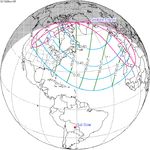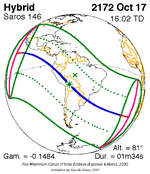Solar_eclipse_of_May_18,_1920
Solar eclipse of May 18, 1920
20th-century partial solar eclipse
A partial solar eclipse occurred on Tuesday, May 18, 1920. A solar eclipse occurs when the Moon passes between Earth and the Sun, thereby totally or partly obscuring the image of the Sun for a viewer on Earth. A partial solar eclipse occurs in the polar regions of the Earth when the center of the Moon's shadow misses the Earth.
























